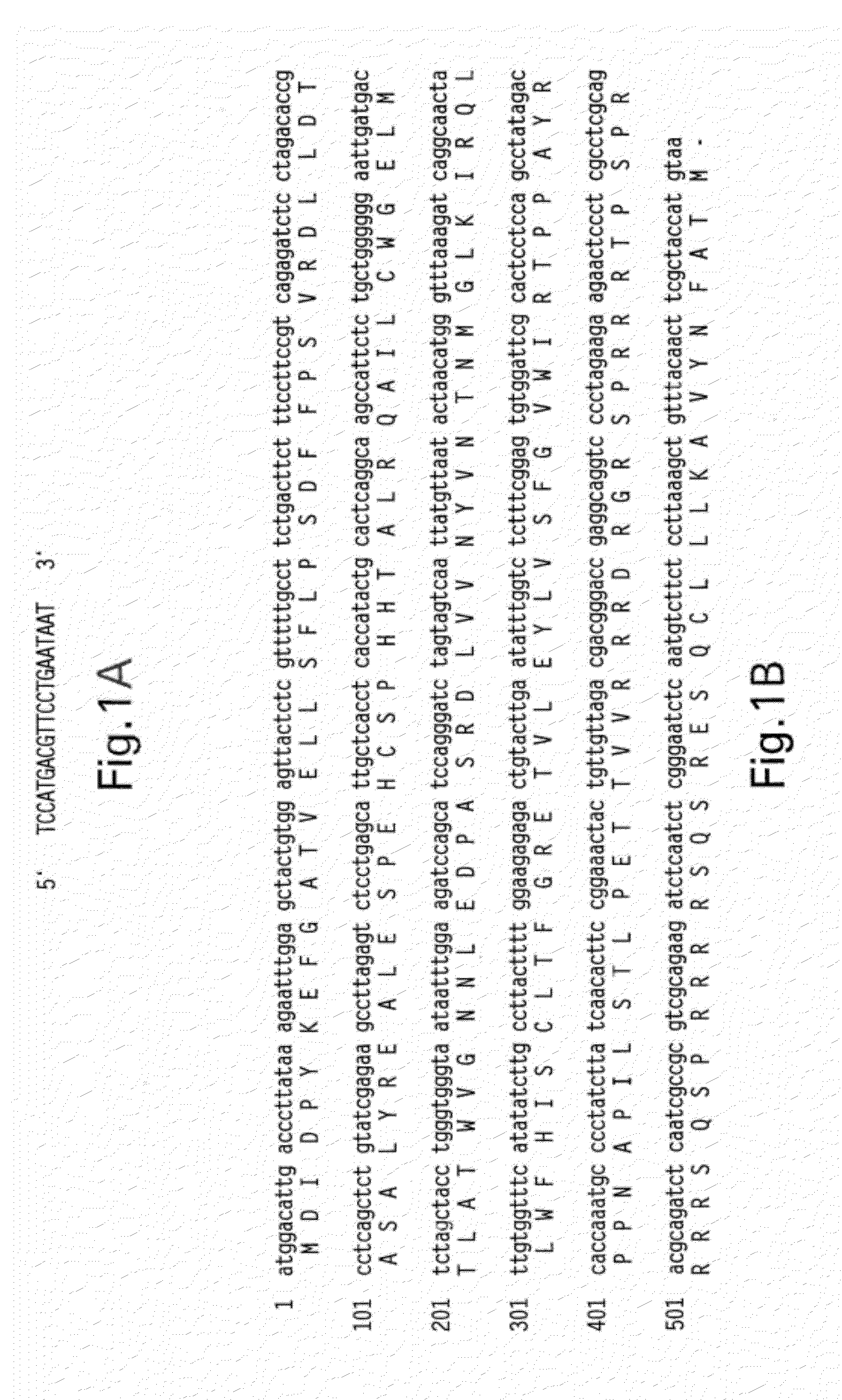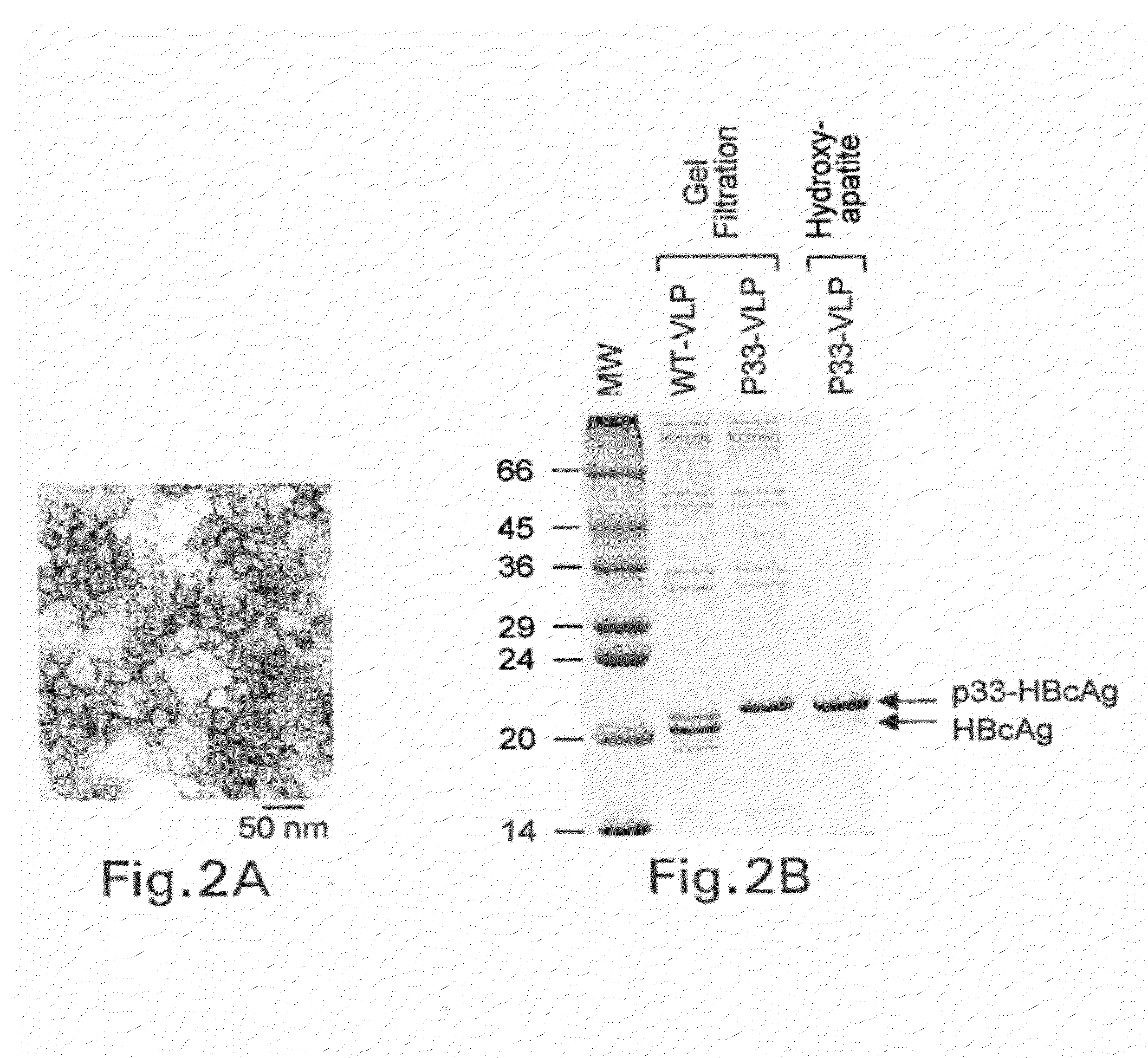Packaging of Immunostimulatory Substances into Virus-Like Particles: Method of Preparation and Use
a technology of immunostimulatory substances and viruses, applied in the field of vaccines, immunology and medicine, can solve the problems of insufficient administration of purified proteins alone, insufficient elicitation of strong immune responses, and insufficient efficiency of purified proteins, so as to enhance b and t cell responses
- Summary
- Abstract
- Description
- Claims
- Application Information
AI Technical Summary
Benefits of technology
Problems solved by technology
Method used
Image
Examples
example 1
Generation of p33-HBcAg VLPs
[0345]The DNA sequence of HBcAg containing peptide p33 from LCMV is given in FIG. 1B. The p33-HBcAg VLPs (p33-VLPs) were generated as follows: Hepatitis B clone pEco63 containing the complete viral genome of Hepatitis B virus was purchased from ATCC. The gene encoding HBcAg was introduced into the EcoRI / HindIII restriction sites of expression vector pkk223.3 (Pharmacia) under the control of a strong tac promoter. The p33 peptide (KAVYNFATM) derived from lymphocytic choriomeningitis virus (LCMV) was fused to the C-terminus of HBcAg (1-185) via a three leucine-linker by standard PCR methods. A clone of E. coli K802 selected for good expression was transfected with the plasmid, and cells were grown and resuspended in 5 ml lysis buffer (10 mM Na2HPO4, 30 mM NaCl, 10 mM EDTA, 0.25% Tween-20, pH 7.0). 200 μl of lysozyme solution (20 mg / ml) was added. After sonication, 4 μl Benzonase and 10 mM MgCl2 was added and the suspension was incubation for 30 minutes at R...
example 2
CpG-Containing Oligonucleotides Can be Packaged into HBcAg VLPs
[0347]Recombinant p33-VLPs were run on a native agarose (1%) gel electrophoresis and stained with ethidium bromide or Coomassie blue for the detection of RNA / DNA or protein (FIG. 3). Bacterial produced VLPs contain high levels of single stranded RNA, which is presumably binding to the arginine repeats appearing near the C-terminus of the HBcAg protein and being geographically located inside the VLPs as shown by X-ray crystallography. The contaminating RNA can be easily digested and so eliminated by incubating the VLPs with RNase A. The highly active RNase A enzyme has a molecular weight of about 14 kDa and is presumably small enough to enter the VLPs to eliminate the undesired ribonucleic acids.
[0348]The recombinant p33-VLPs were supplemented with CpG-oligonucleotides (FIG. 1A) before digestion with RNase A. As shown in FIG. 4 the presence of CpG-oligonucleotides preserved the capsid structure as shown by similar migrati...
example 3
CpG-Oligonucleotides Can be Packaged into VLPs by Removal of the RNA with RNAse and Subsequent Packaging of Oligonucleotides into VLPs
[0349]The p33-VLPs (containing bacterial single-stranded RNA) were first incubated with RNase A to remove the RNA and in a second step the immunostimulating CpG-oligonucleotides (with normal phosphodiester bonds but also with phosphorothioate modification of the phosphate backbone) was supplemented to the samples (FIG. 6). This experiment clearly shows that the CpG-oligonucleotides are not absolutely required simultaneously during the RNA degradation reaction but can be added at a later time.
PUM
| Property | Measurement | Unit |
|---|---|---|
| Time | aaaaa | aaaaa |
| Immunostimulation | aaaaa | aaaaa |
| Immunogenicity | aaaaa | aaaaa |
Abstract
Description
Claims
Application Information
 Login to View More
Login to View More - R&D
- Intellectual Property
- Life Sciences
- Materials
- Tech Scout
- Unparalleled Data Quality
- Higher Quality Content
- 60% Fewer Hallucinations
Browse by: Latest US Patents, China's latest patents, Technical Efficacy Thesaurus, Application Domain, Technology Topic, Popular Technical Reports.
© 2025 PatSnap. All rights reserved.Legal|Privacy policy|Modern Slavery Act Transparency Statement|Sitemap|About US| Contact US: help@patsnap.com



